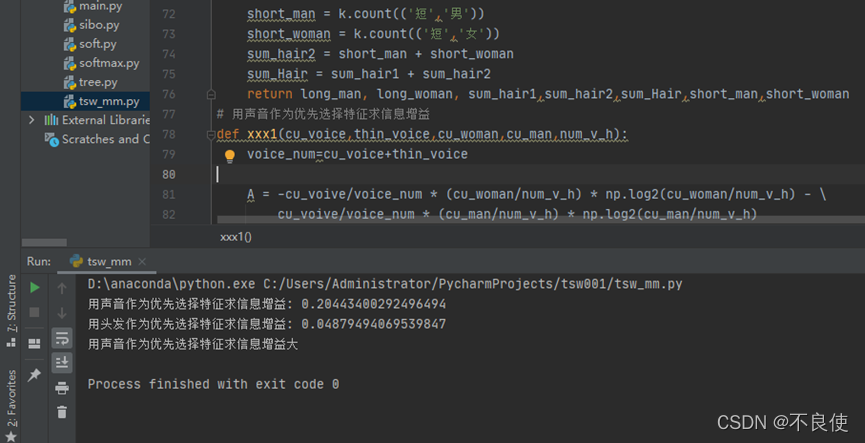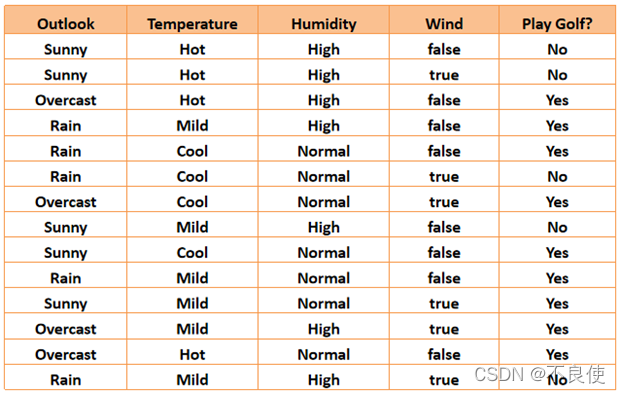一、实验目的
使用Python实现ID3决策树中特征选择的先后顺序。
二、实验原理
(1)信息熵
熵是对体系中混乱程度的度量。
熵越大则该体系越混乱。熵的计算公式如下所示:
l(xi)=-log2p(xi)
其中,xi表示第i个分类,p(xi)表示选择第i个分类的概率函数,其中 。
熵H(x)可表示为:
(2)条件熵
(3)信息增益
因此,决策树分类选特征应选信息增益最大的特征,也就是选择的特征能够使该系统从混乱到有序最快的特征。
三、Python包
(1)numpy
四、实验内容
(1)案例描述:通过头发和声音2个特征来判断学生的性别。使用Python实现求出其信息增益,并得出哪个特征优先被选择(注:数据处理使用程序计算)。
数据集如下:
注:数据集可直接用矩阵来描述:
[[‘长’, ‘粗’, ‘男’],
[‘短’, ‘粗’, ‘男’],
[‘短’, ‘粗’, ‘男’],
[‘长’, ‘细’, ‘女’],
[‘短’, ‘细’, ‘女’],
[‘短’, ‘粗’, ‘女’],
[‘长’, ‘粗’, ‘女’],
[‘长’, ‘粗’, ‘女’]]
代码:
import numpy as np
import math
# 求出总熵
def getData(pri_data):
data = np.array(pri_data)
boys = 0
girls = 0
for i in range(len(data)):
if data[i][2] == '男':
boys += 1
else:
girls += 1
a = boys / len(data)
total_shang = -(a) * math.log(a, 2) - (1 - a) * math.log((1 - a), 2)
return total_shang
def empty1(pri_data):
hair = [] #['长', '短', '短', '长', '短', '短', '长', '长']
voice = [] #['粗', '粗', '粗', '细', '细', '粗', '粗', '粗']
sex = [] #['男', '男', '男', '女', '女', '女', '女', '女']
for one in pri_data:
hair.append(one[0])
voice.append(one[1])
sex.append(one[2])
cu_voive = voice.count('粗') #6
thin_voice = voice.count('细') #2
# 一维列表合并成多维列表
d = []
for i in range(len(hair)):
for j in range(len(voice)):
if i == j:
for k in range(len(sex)):
if j == k:
t = [hair[i], voice[j], sex[k]]
d.append(t)
# print(d)
a = d.count(['短', '粗', '男']) #2
b = d.count(['短', '粗', '女']) #1
c = d.count(['长', '粗', '男']) #1
e = d.count(['长', '粗', '女']) #2
f = d.count(['长', '细', '女']) #1
g = d.count(['短', '细', '女']) #1
#一维列表合并成二维列表
z=list(zip(voice,sex))
cu_woman =z.count(('粗','女'))
cu_man = z.count(('粗','男'))
num_v_h = (cu_woman + cu_man)
return cu_voive, thin_voice, cu_woman, cu_man, num_v_h
def empty2(pri_data):
hair = [] # ['长', '短', '短', '长', '短', '短', '长', '长']
voice = [] # ['粗', '粗', '粗', '细', '细', '粗', '粗', '粗']
sex = [] # ['男', '男', '男', '女', '女', '女', '女', '女']
for one in pri_data:
hair.append(one[0])
voice.append(one[1])
sex.append(one[2])
# 一维列表合并成二维列表
k = list(zip(hair, sex))
long_man =k.count(('长','男'))
long_woman = k.count(('长','女'))
sum_hair1 = long_man + long_woman
short_man = k.count(('短','男'))
short_woman = k.count(('短','女'))
sum_hair2 = short_man + short_woman
sum_Hair = sum_hair1 + sum_hair2
return long_man, long_woman, sum_hair1,sum_hair2,sum_Hair,short_man,short_woman
# 用声音作为优先选择特征求信息增益
def xxx1(cu_voice,thin_voice,cu_woman,cu_man,num_v_h):
voice_num=cu_voice+thin_voice
A = -cu_voive/voice_num * (cu_woman/num_v_h) * np.log2(cu_woman/num_v_h) - \
cu_voive/voice_num * (cu_man/num_v_h) * np.log2(cu_man/num_v_h)
sum_v = getData(pri_data) - A
return sum_v
# 用头发作为优先选择特征求信息增益
def xxx2(long_man, long_woman, sum_hair,sum_hair2,sum_Hair,short_man,short_woman):
B = -sum_hair/sum_Hair* (long_man/sum_hair) * np.log2(long_man/sum_hair) - \
sum_hair/sum_Hair * (long_woman/sum_hair) * np.log2(long_woman/sum_hair) - sum_hair2/sum_Hair * (short_man/sum_hair2) * np.log2(short_man/sum_hair2)\
- sum_hair2/sum_Hair* (short_woman/sum_hair2) * np.log2(short_woman/sum_hair2)
sum_h = getData(pri_data) - B
return sum_h
if __name__ == "__main__":
pri_data = [['长', '粗', '男'], ['短', '粗', '男'], ['短', '粗', '男'],
['长', '细', '女'], ['短', '细', '女'], ['短', '粗', '女'],
['长', '粗', '女'], ['长', '粗', '女']]
total_shang=getData(pri_data)
cu_voive, thin_voice, cu_woman, cu_man, num_v_h=empty1(pri_data)
sum1 = xxx1(cu_voive, thin_voice, cu_woman, cu_man, num_v_h)
print('用声音作为优先选择特征求信息增益:',sum1)
long_man, long_woman, sum_hair1, sum_hair2, sum_Hair, short_man, short_woman=empty2(pri_data)
sum2 = xxx2(long_man, long_woman, sum_hair1, sum_hair2, sum_Hair, short_man, short_woman)
print('用头发作为优先选择特征求信息增益:',sum2)
if sum1 > sum2:
print("用声音作为优先选择特征求信息增益大")
else:
print("用头发作为优先选择特征求信息增益大")截图:

四、实验内容
(1)案例描述:通过天气、温度、湿度、是否有风4个特征来决策是否打球。使用Python实现求出其信息增益,并得出哪个特征优先被选择(注:数据处理使用程序计算,数据见data.xls)。
数据集如下:
代码:
import xlrd
import numpy as np
workbook=xlrd.open_workbook("data.xls")
sheet=workbook.sheet_by_name("Sheet1")
row_count=sheet.nrows
col_count=sheet.ncols
data_list=[]
for i in range(1,row_count):
data_list.append(sheet.row_values(i))
play_golf_number=0
no_play_golf_number=0
total_count=0
for i in data_list:
if i[col_count-1]=="Yes":
play_golf_number+=1
else:
no_play_golf_number+=1
total_count+=1
a=play_golf_number/total_count
#求出总熵
total_shang=-(a)*np.log2(a)-(1-a)*np.log2(1-a)
print(total_shang)
#求出各分熵,开始判别第一特征
#1.根据天气
b=(5/14)*((-2/5)*np.log2(2/5)-(3/5)*np.log2(3/5))+(5/14)*((-2/5)*np.log2(2/5)-(3/5)*np.log2(3/5))
#2.根据温度
c=(4/14)*((-1/2)*np.log2(1/2)-(1/2)*np.log2(1/2))+(4/14)*((-3/4)*np.log2(3/4)-(1/4)*np.log2(1/4))+(6/14)*((-2/3)*np.log2(2/3)-(1/3)*np.log2(1/3))
#3.根据湿度
d=(7/14)*((-3/7)*np.log2(3/7)-(4/7)*np.log2(4/7))+(7/14)*((-6/7)*np.log2(6/7)-(1/7)*np.log2(1/7))
#4.根据风力
e=(8/14)*((-6/8)*np.log2(6/8)-(2/8)*np.log2(2/8))+(6/14)*((-1/2)*np.log2(1/2)-(1/2)*np.log2(1/2))
y1=1-b
y2=1-c
y3=1-d
y4=1-e
shang_list1=[y1, y2, y3, y4]
first_feature=min(shang_list1)
if y1==first_feature:
print("天气是第一特征")
if y2 == first_feature:
print("温度是第一特征")
if y3==first_feature:
print("湿度是第一特征")
if y4==first_feature:
print("风力是第一特征")
#开始判别第二特征
#1.根据天气
f=(5/14)*((-2/5)*np.log2(2/5)-(3/5)*np.log2(3/5))+(5/14)*((-2/5)*np.log2(2/5)-(3/5)*np.log2(3/5))
#2.根据湿度
g=(7/14)*((-3/7)*np.log2(3/7)-(4/7)*np.log2(4/7))+(7/14)*((-6/7)*np.log2(6/7)-(1/7)*np.log2(1/7))
#3.根据风力
h=(8/14)*((-6/8)*np.log2(6/8)-(2/8)*np.log2(2/8))+(6/14)*((-1/2)*np.log2(1/2)-(1/2)*np.log2(1/2))
y5=1-f
y6=1-g
y7=1-h
shang_list2=[y5,y6,y7]
second_feature=min(shang_list2)
if y5==second_feature:
print("天气是第二特征")
if y6==second_feature:
print("湿度是第二特征")
if y7==second_feature:
print("风力是第二特征")
#开始判别第三特征
#1.根据天气
i=(3/11)*((-1/3)*np.log2(1/3)-(2/3)*np.log2(2/3))+(4/11)*((-1/2)*np.log2(1/2)-(1/2)*np.log2(1/2))
#2.根据湿度
j=(6/11)*((-1/2)*np.log2(1/2)-(1/2)*np.log2(1/2))+(5/11)*((-4/5)*np.log2(4/5)-(1/5)*np.log2(1/5))
y8=1-i
y9=1-j
shang_list3=[y8,y9]
third_feature=min(shang_list3)
if y8==third_feature:
print("天气是第三特征")
if y9==third_feature:
print("湿度是第三特征")
print("天气是第四特征")









